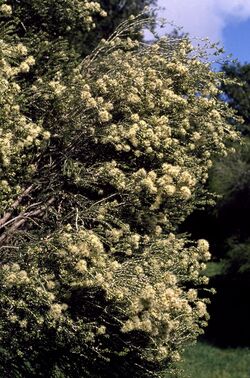Biology:Melaleuca xerophila
| Melaleuca xerophila | |
|---|---|

| |
| At the Waite Institute | |
| Scientific classification | |
| Kingdom: | Plantae |
| Clade: | Tracheophytes |
| Clade: | Angiosperms |
| Clade: | Eudicots |
| Clade: | Rosids |
| Order: | Myrtales |
| Family: | Myrtaceae |
| Genus: | Melaleuca |
| Species: | M. xerophila
|
| Binomial name | |
| Melaleuca xerophila Barlow[1]
| |
Melaleuca xerophila is a shrub or small tree in the myrtle family Myrtaceae and is native to arid parts of South Australia and Western Australia. It is a large shrub with narrow leaves and heads of white or cream-coloured flowers in spring.
Description
Melaleuca xerophila is a large shrub or small spreading tree which grows to a height of 3–6 m (10–20 ft) and has fibrous or papery bark. The leaves are alternately or spirally arranged, narrow elliptic in shape, 1.8–5.2 mm (0.07–0.2 in) long and 0.9–1.5 mm (0.04–0.06 in) wide.[2][3]
The flowers are white or cream-coloured and are arranged in heads near the ends of the branches, each head usually consisting of one to nine individual flowers. The base of the flower is 1.6–2.2 millimetres (0.06–0.09 in) long. The stamens are arranged in bundles of five around the flower, with 15 to 22 stamens in each bundle. Flowering occurs in October and November and is followed by fruit which are woody capsules, 2.5–3.5 mm (0.098–0.14 in) long and wide, cup-shaped or barrel-shaped and which occur singly or in clusters.[2][3]
Taxonomy and naming
Melaleuca xerophila was first formally described in 1988 by Bryan Barlow in Australian Systematic Botany.[4][5] The specific epithet (xerophila) is derived from the Ancient Greek words ξερός (xeros), meaning “dry”[6]:285 and φίλος (phílos), meaning “dear one" or "friend”,[6]:355 referring to the arid habitat of this species.[3]
Distribution and habitat
This melaleuca occurs in arid locations in central South Australia and from the Roy Hill district south to the Leonora - Laverton district in Western Australia. It usually grows in depressions near salt lakes in calcareous soils.[3][7]
Conservation
Melaleuca xerophila is classified as "not threatened" by the Government of Western Australia Department of Parks and Wildlife.[7]
Uses
Essential oils
This leaf oil of this species is mostly monoterpenes but the yield is low.[3]
Horticulture
This species may have use in land rehabilitation in very dry climates.[3]
References
- ↑ "Melaleuca xerophila". Plants of the World Online. https://powo.science.kew.org/taxon/urn:lsid:ipni.org:names:935736-1.
- ↑ Jump up to: 2.0 2.1 Holliday, Ivan (2004). Melaleucas : a field and garden guide (2nd ed.). Frenchs Forest, N.S.W.: Reed New Holland Publishers. pp. 314–315. ISBN 1876334983.
- ↑ Jump up to: 3.0 3.1 3.2 3.3 3.4 3.5 Brophy, Joseph J.; Craven, Lyndley A.; Doran, John C. (2013). Melaleucas : their botany, essential oils and uses. Canberra: Australian Centre for International Agricultural Research. ISBN 9781922137517.
- ↑ "Melaleuca xerophila". APNI. https://biodiversity.org.au/boa/instance/apni/546299. Retrieved 12 March 2015.
- ↑ Barlow, BA; Cowley, KJ (1988). "Contributions to a revision of Melaleuca (Myrtaceae): 4–6". Australian Systematic Botany 1 (2): 122–123. doi:10.1071/SB9880095.
- ↑ Jump up to: 6.0 6.1 Brown, Roland Wilbur (1956). The Composition of Scientific Words. Washington, D.C.: Smithsonian Institution Press.
- ↑ Jump up to: 7.0 7.1 "Melaleuca xerophila". FloraBase. Western Australian Government Department of Parks and Wildlife. https://florabase.dpaw.wa.gov.au/browse/profile/5991.
Wikidata ☰ Q15372734 entry
 |

